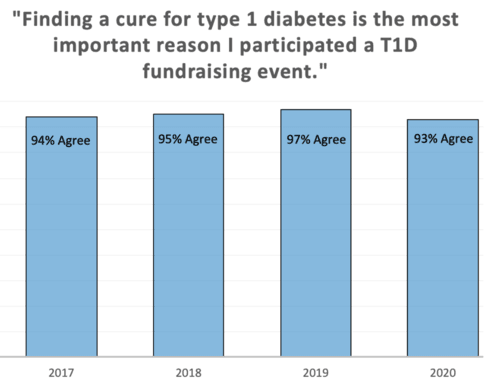
Picture Source: Annual JDCA Surveys of T1D Event Participants
This report will summarize key findings from the sixth annual survey of JDRF & ADA event participants. The purpose of the survey is to understand what motivates T1D donors to give their time and money to these events. This year’s survey included trend questions from prior years, as well as new questions meant to gauge reactions as the organizations transitioned to virtual fundraising platforms.
COVID-19 has directly impacted the T1D fundraising events which generate significant revenue for both JDRF and the ADA. Since March 2020, both JDRF and the ADA have been forced to move most of their grassroots fundraising events to virtual platforms.
The key finding of this years’ survey is that virtual event participants, like the in-person participants surveyed in previous years, took part because they wanted to raise money to fund T1D cure research. See opening chart.
The survey was distributed in September 2020 to a representative sample of people who participated, either in-person or virtually, in JDRF or ADA events in the past year. The key findings are summarized below.
Key Survey Findings:
- T1D fundraising event participation is on a three-year decline, which has now been exacerbated by COVID-19. The percentages below show the number of survey respondents who said they participated in a JDRF or ADA fundraising event in the past year:
- 2020: 26%
- 2019: 37%
- 2018: 51%
- Donors choose to participate in virtual events because they believe they are funding T1D cure research, their top priority.
- 93% of event participants said finding a cure for T1D was the #1 reason they participated in a T1D fundraising event.
- 86% of event participants expected at least half of the money raised would be used to fund T1D cure research.
- Those who took part virtually in 2020 felt they were able to raise about the same amount of money for virtual events as in-person events, but the virtual events were less enjoyable than in-person events.
- 55% of people were able to raise “about the same” amount of money at the virtual events as in-person.
- 69% of virtual fundraising participants said the virtual event was “not as good” as in-person.
- JDRF and ADA fundraisers are less likely to donate when they learn how much money the organizations actually spend on T1D research grants – 38 cents of every dollar at JDRF and 2 cents of every dollar at ADA.
- 7/10 fundraisers are less likely to donate to JDRF upon learning of their T1D research grant allocation.
- 8/10 fundraisers are less likely to donate to the ADA upon learning of their T1D research grant allocation.
Conclusion:
It is difficult to replicate the sense of community fostered at an in-person fundraising event on an online platform. But six years of surveys show that what connects the participants at these events - even more than their desire for in-person community - is their desire to fund T1D cure research.
While COVID-19 has undoubtedly had an adverse effect on grassroots fundraising, the decrease in donor involvement at JDRF and the ADA cannot be solely attributed to the pandemic. As long as JDRF and the ADA dedicate only small portions of what they raise at events to T1D cure research, they will be misaligned with their own donors and therefore at risk of jeopardizing a powerful funding source.
In order to ensure their long-term viability, these organizations should focus their efforts on funding cure research and repairing the misalignment of donor interest and organizational spending.
- T1D fundraising event participation is on a three-year decline, which has now been exacerbated by Covid-19. The percentages below show the number of survey respondents who said they participated in a JDRF or ADA fundraising event in the past year:
- 2020: 26%
- 2019: 37%
- 2018: 51%
- Donors choose to participate in virtual events because they believe they are funding T1D cure research, their top priority.
- 93% of event participants said finding a cure for T1D was the #1 reason they participated in a T1D fundraising event.
- 86% of event participants expected at least half of the money raised would be used to fund T1D cure research.
- Those who took part virtually in 2020 felt they were able to raise about the same amount of money for virtual events as in-person events, but the events themselves were less enjoyable than in-person events.
- 55% of people were able to raise “about the same” amount of money at the virtual events as in-person.
- 69% of virtual fundraising participants said the virtual event was “not as good” as in-person.
- JDRF and ADA fundraisers are less likely to donate when they learn how much money the organizations actually spend on T1D research grants – 38 cents of every dollar at JDRF and 2 cents of every dollar at ADA.
- 7/10 fundraisers are less likely to donate to JDRF upon learning of their T1D research grant allocation.
- 8/10 fundraisers are less likely to donate to the ADA upon learning of their T1D research grant allocation.
Conclusion:
It is difficult to replicate the sense of community fostered at an in-person fundraising event on an online platform. But six years of surveys show that what connects the participants in these events - even more than their desire for in-person community - is their desire to fund T1D cure research.
While COVID-19 has undoubtedly had an adverse effect on grassroots fundraising, the decrease in donor involvement at JDRF and the ADA cannot be solely attributed to the pandemic. As long as JDRF and the ADA dedicate only small portions of what they raise at events to T1D cure research, they will be misaligned with their own donors and therefore at risk. In order to ensure their long-term viability, these organizations should focus their efforts on funding cure research and repairing the misalignment of donor interest and organizational spending.
